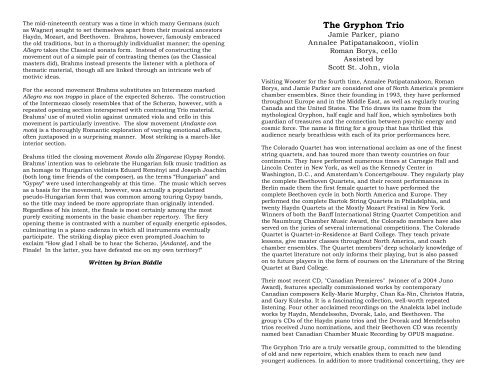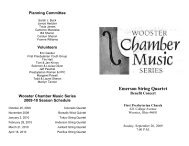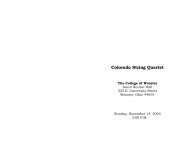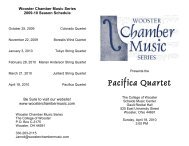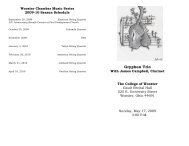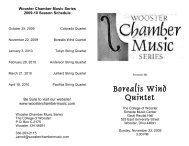The mid-nineteenth century was a time in which many Germans (suchas Wagner) sought to set themselves apart from their musical ancestorsHaydn, Mozart, and Beethoven. Brahms, however, famously embracedthe old traditions, but in a thoroughly individualist manner; the openingAllegro takes the Classical sonata form. Instead of constructing themovement out of a simple pair of contrasting themes (as the Classicalmasters did), Brahms instead presents the listener with a plethora ofthematic material, though all are linked through an intricate web ofmotivic ideas.For the second movement Brahms substitutes an Intermezzo markedAllegro ma non troppo in place of the expected Scherzo. The constructionof the Intermezzo closely resembles that of the Scherzo, however, with arepeated opening section interspersed with contrasting <strong>Trio</strong> material.Brahms’ use of muted violin against unmated viola and cello in thismovement is particularly inventive. The slow movement (Andante conmoto) is a thoroughly Romantic exploration of varying emotional affects,often juxtaposed in a surprising manner. Most striking is a march-likeinterior section.Brahms titled the closing movement Rondo alla Zingarese (Gypsy Rondo).Brahms’ intention was to celebrate the Hungarian folk music tradition asan homage to Hungarian violinists Eduard Reményi and Joseph Joachim(both long time friends of the composer), as the terms “Hungarian” and“Gypsy” were used interchangeably at this time. The music which servesas a basis for the movement, however, was actually a popularizedpseudo-Hungarian form that was common among touring Gypsy bands,so the title may indeed be more appropriate than originally intended.Regardless of his intent, the finale is most certainly among the mostpurely exciting moments in the basic chamber repertory. The fieryopening theme is contrasted with a number of equally energetic episodes,culminating in a piano cadenza in which all instruments eventuallyparticipate. The striking display piece even prompted Joachim toexclaim “How glad I shall be to hear the Scherzo, [Andante], and theFinale! In the latter, you have defeated me on my own territory!”Written by Brian BiddleThe <strong>Gryphon</strong> <strong>Trio</strong>Jamie Parker, pianoAnnalee Patipatanakoon, violinRoman Borys, celloAssisted byScott St. John, violaVisiting <strong>Wooster</strong> for the fourth time, Annalee Patipatanakoon, RomanBorys, and Jamie Parker are considered one of North America's premierechamber ensembles. Since their founding in 1993, they have performedthroughout Europe and in the Middle East, as well as regularly touringCanada and the United States. The <strong>Trio</strong> draws its name from themythological <strong>Gryphon</strong>, half eagle and half lion, which symbolizes bothguardian of treasures and the connection between psychic energy andcosmic force. The name is fitting for a group that has thrilled thisaudience nearly breathless with each of its prior performances here.The Colorado Quartet has won international acclaim as one of the fineststring quartets, and has toured more than twenty countries on fourcontinents. They have performed numerous times at Carnegie Hall andLincoln Center in New York, as well as the Kennedy Center inWashington, D.C., and Amsterdam’s Concertgebouw. They regularly playthe complete Beethoven Quartets, and their recent performances inBerlin made them the first female quartet to have performed thecomplete Beethoven cycle in both North America and Europe. Theyperformed the complete Bartok String Quartets in Philadelphia, andtwenty Haydn Quartets at the Mostly Mozart Festival in New York.Winners of both the Banff International String Quartet Competition andthe Naumburg <strong>Chamber</strong> <strong>Music</strong> Award, the Colorado members have alsoserved on the juries of several international competitions. The ColoradoQuartet is Quartet-in-Residence at Bard College. They teach privatelessons, give master classes throughout North America, and coachchamber ensembles. The Quartet members’ deep scholarly knowledge ofthe quartet literature not only informs their playing, but is also passedon to future players in the form of courses on the Literature of the StringQuartet at Bard College.Their most recent CD, "Canadian Premieres" (winner of a 2004 JunoAward), features specially commissioned works by contemporaryCanadian composers Kelly-Marie Murphy, Chan Ka-Nin, Christos Hatzis,and Gary Kulesha. It is a fascinating collection, well-worth repeatedlistening. Four other acclaimed recordings on the Analekta label includeworks by Haydn, Mendelssohn, Dvorak, Lalo, and Beethoven. Thegroup's CDs of the Haydn piano trios and the Dvorak and Mendelssohntrios received Juno nominations, and their Beethoven CD was recentlynamed best Canadian <strong>Chamber</strong> <strong>Music</strong> Recording by OPUS magazine.The <strong>Gryphon</strong> <strong>Trio</strong> are a truly versatile group, committed to the blendingof old and new repertoire, which enables them to reach new (andyounger) audiences. In addition to more traditional concertizing, they are
known for innovative performances, sometimes at venues atypical forchamber music (e.g., a Latin dance club in downtown Toronto). Possiblytheir most ambitious project of late is "Constantinople," a multimediaevent composed by Christos Hatzis, which the <strong>Trio</strong> commissioned andproduced. The collaboration is presented as a musical, theatrical, visualexploration of faith, cultural diversity, myth and the human spirit."Constantinople" premiered at the Banff Summer Arts Festival in July2004, and will begin international touring later this year. The <strong>Gryphon</strong><strong>Trio</strong> commissioned Chan Ka-Nin to create another unusual performanceproject, "...and the masks evoke..." (which can be heard on the JunowinningCD), which reflects influences from Northwest Pacific indigenousculture and Chan's own Hong Kong background.The <strong>Gryphon</strong> <strong>Trio</strong> has been Ensemble-in-Residence at the <strong>Music</strong> Toronto<strong>Chamber</strong> <strong>Series</strong> since 1988. Performances can be heard regularly onradio and television broadcasts in Canada, the United States, Europe,and Asia. In addition to a busy performance schedule and teaching at theUniversity of Toronto, the three give frequent master classes, chambermusic coachings, composition workshops, and school presentations.On a personal note, Annalee Patipatanakoon and Roman Borys weremarried in late 2004.Written by Sarah J. BuckScott St. John captures the attention of the musical world throughriveting performances on violin and viola. A graduate of the CurtisInstitute and prize-winner of numerous competitions and awards,including a 2003 Avery Fisher Career Grant, he brings superb technique,warmth and musicianship to everything he plays. Recent broadcastsinclude CBC radio, NPR’s "Performance Today", and A&E’s “Breakfastwith the Arts”. Concerto appearances include Calgary, Cincinnati,Grand Rapids, Montreal, Toledo, Utah and Winnipeg. He has delightedrecital and chamber audiences around the globe, stretching from Japan’sCasals Hall to New York’s Lincoln Center and Carnegie Hall. Scottcurrently serves on the faculty of the University of Toronto. "SalonParisien," on CBC Records, is his newest release.PROGRAM NOTESLudwig van Beethoven (1770-1827)PIANO TRIO IN B-FLAT MAJOR, "ARCHDUKE", OP. 97 – Though oftenlabeled as the seventh of the dozen string trios credited to Beethoven, theArchduke is chronologically the composer’s final completed entry in thegenre. Though sketches were made in 1810, the bulk of the work wascomposed in March 1811, the year of the seventh and eighthsymphonies. The piece was dedicated (as the title suggests) to ArchdukeRudolph, the son of Emperor Leopold II. A pupil of Beethoven since theage of fifteen, Rudolph was an enthusiastic champion of the composer’swork. Beethoven’s respect for the Archduke appeared genuine, and anumber of other significant works (including the monumental Missasolemnis) bear the same dedication.The majestic grace found in the opening moments of the Allegro moderatoseems to justify piece’s regal inspiration. Immediately one may observethat the principal musical force driving the opening movement is aprofound sense of lyricism. Is this the same Beethoven who only a fewyears earlier wove virtually the entire Fifth Symphony from a single,obstinate “Short-Short-Short-Long” motive? Indeed, it is rather astylistic harbinger of the composer’s famous late period, a direct ancestorof the late quartets, the Missa solemnis, and the Ninth Symphony.Following is a Scherzo marked Allegro. It is, in the words of musicologistRobert Haven Schauffler, “one of the Master’s foremost contributions tothis form of his invention - the form in which the lion of wit was firstsuccessfully made to lie down with the lamb of melody.” The <strong>Trio</strong> sectionfeatures a disconcerting melodic line which slinks through some quitechromatic moments.The sublime third movement (marked Andante cantabile) is oftencompared with the celebrated slow movement of the Ninth Symphony. Ahymn-like theme is followed by a set of variations that vary in emotionalaffect from dour to light and playful. A rondo marked Allegro moderatofollows without pause. It arrives as a raucous interruption of theprevious movement’s genteel serenity, bubbling infectiously toward itsrollicking conclusion.Perhaps Beethoven invoked the royal personage in the “Archduke” as anobservance of the nobility whose power (and therefore ability to supportthe arts) was rapidly declining. The first performance, in fact, occurrednot in the nobleman’s private confines but in a charity concert for themilitary, with Beethoven himself at the piano. By this time, though, thecomposer was almost totally deaf and was a mere shadow of the virtuosicperformer he once was. Composer Ludwig Spohr recounted theperformance, “In forte passages the poor deaf man pounded on the keystill the strings jangled, and in piano he played so softly that whole groupsof tones were omitted… I was deeply saddened at so hard a fate.”Beethoven took the harsh criticism to heart; aside from accompanying,he never performed as a pianist in public again.Johannes Brahms (1833-1897)QUARTET FOR PIANO, VIOLIN, VIOLA AND VIOLONCELLO IN GMINOR, OP. 25 – After focusing much of his compositional effort to thelarge-scale first <strong>Piano</strong> Concerto in the 1850s, Brahms turned to the moreintimate genre of chamber music in the early 1860s. Works from thistime include two string sextets, a horn trio, a cello sonata, two pianoquartets, and two piano quartets (Opp. 25 and 26). The first of thesequartets was sketched in 1859 but not completed until September 1861.It was first performed later that year in the composer’s home city ofHamburg with Clara Schumann playing piano, but it did not receivewidespread attention elsewhere at first.


